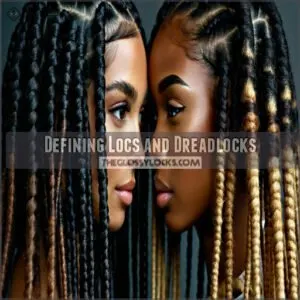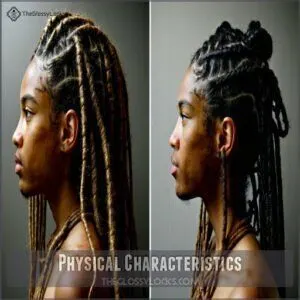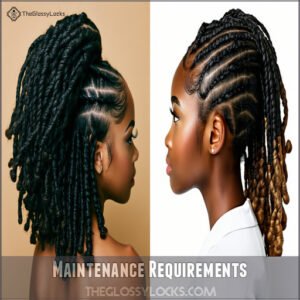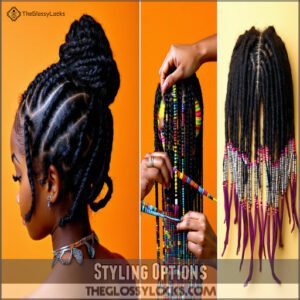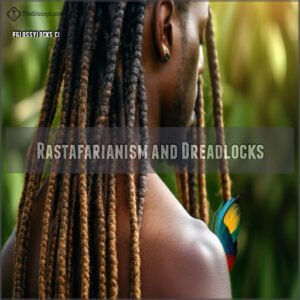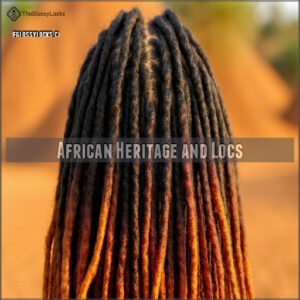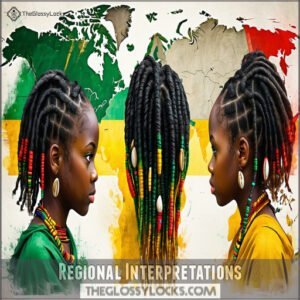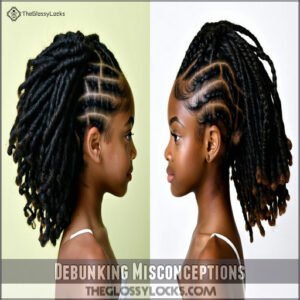This site is supported by our readers. We may earn a commission, at no cost to you, if you purchase through links.
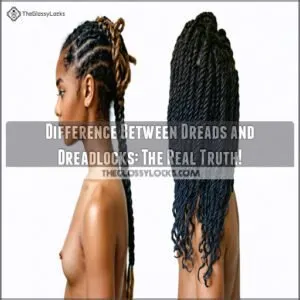 When exploring the difference between dreads and dreadlocks, you’ll find more than just a name game.
When exploring the difference between dreads and dreadlocks, you’ll find more than just a name game.
Dreadlocks naturally form through hair matting, sporting a rough, rope-like texture with merged roots.
Locs, on the other hand, are painstakingly crafted through twisting and interlocking, resulting in neat, sectioned roots and a smoother appearance.
Your hair’s texture plays a vital role in how they develop.
While both styles celebrate cultural identity and personal expression, locs require more maintenance—weekly washing and regular retwisting—compared to dreadlocks’ more relaxed upkeep.
Whether you’re drawn to free-form looks or precise partitions, each style tells a unique story.
Table Of Contents
- Key Takeaways
- Defining Locs and Dreadlocks
- Locs Vs Dreadlocks
- Cultural Significance Explained
- Similarities and Differences
- Debunking Misconceptions
- Frequently Asked Questions (FAQs)
- How often should I wash my locs/dreadlocks? What products should I use?
- Can I go swimming with locs/dreadlocks? Will they unravel if wet?
- Are dreadlocks considered professional in workplaces?
- How long does it take to form locs?
- Can people with straight hair get dreadlocks?
- Do dreadlocks cause hair damage over time?
- What products work best for loc maintenance?
- Conclusion
Key Takeaways
- You’ll notice that dreadlocks naturally form through hair matting, creating a rough, rope-like texture, while locs are intentionally crafted with neat, sectioned roots through twisting or interlocking.
- Dreadlocks require minimal upkeep with a relaxed maintenance approach, whereas locs need regular retwisting and weekly care for their polished appearance.
- Locs and dreadlocks carry deep cultural significance, symbolizing identity, heritage, and spiritual expression rooted in African and Rastafarian traditions.
- Locs feature precise, clean partitions with a smoother look, while dreadlocks have merged roots and a freeform, untamed aesthetic.
Defining Locs and Dreadlocks
You might’ve heard the terms "locs" and "dreadlocks" used interchangeably, but they’re not exactly the same thing.
When you’re curious about these unique hairstyles, understanding their distinct formation methods and cultural roots can help you appreciate the rich history and personal expression behind each style, particularly the significance of locs.
Formation Methods
In the sphere of hair transformation, locs and dreads take different paths to creation.
Twisting techniques and interlocking methods carefully shape locs, while the neglect method allows dreads to form naturally through hair’s inherent matting process.
A range of dreadlocks formation methods are available for those seeking more structured results.
Your hair’s texture, patience, and personal style guide the locking journey, turning each strand into a unique expression of identity.
Cultural Significance
After mastering formation techniques, you’ll discover locs and dreadlocks are more than just hairstyles—they’re powerful symbols of identity and spiritual expression.
Each strand tells a story of cultural significance, challenging social perceptions and representing deep connections to heritage.
Whether Rastafarian roots or African traditions, these hairstyles embody personal journeys of belonging and resistance, as explained in this locs and dreads comparison.
Historical Context
Locked hairstyles whisper ancient stories of cultural resilience and spiritual identity.
Tracing back thousands of years, these intricate hair traditions emerged across African and Indian civilizations, symbolizing communal connections.
Historical evidence reveals locked hair’s deep roots in Egyptian artifacts, challenging contemporary misconceptions about its origins.
From spiritual practices to resistance against cultural suppression, these hairstyles embody profound historical significance.
Understanding loc washing frequency is essential for maintaining the health and integrity of these hairstyles, which are a part of cultural resilience.
Locs Vs Dreadlocks
You’ve probably heard the terms "locs" and "dreadlocks" tossed around like they’re the same thing, but they’re actually two distinct hairstyles with unique origins and characteristics.
If you’re curious about the real differences between these iconic hair techniques, you’re in the right place to understand how locs and dreadlocks aren’t just similar-looking styles, but representations of cultural expression and personal identity.
Physical Characteristics
Let’s break down the unique physical characteristics that set dreads and locs apart.
Check out this quick comparison:
| Characteristic | Dreads | Locs |
|---|---|---|
| Root Structure | Merged, less defined | Neat, clearly sectioned |
| Texture | Rope-like, rough | Smoother, more polished |
| Hair Density | Often thicker | More uniform |
| Overall Look | Relaxed, free-form | Structured, intentional |
Your hair tells a story – and these styles speak volumes about personal expression and cultural roots.
Maintenance Requirements
After exploring their distinct looks, your loc and dread maintenance journey unfolds differently.
Check out this quick maintenance comparison:
| Aspect | Locs | Dreadlocks |
|---|---|---|
| Washing | Weekly | Bi-weekly |
| Retwisting | 4-6 weeks | Minimal |
| Product Usage | Specialized | Light |
| Palm Rolling | Regular | Occasional |
| Daily Routine | Structured | Relaxed |
Your hair care routine depends on texture, lifestyle, and personal preference – each strand tells a unique story.
A wide array of dreadlock maintenance products can further personalize your routine.
Styling Options
After keeping your locs neat and tidy, you’ll want to play with some killer styles.
A wide variety of locs styling products are available to help achieve these looks.
Check out these awesome options:
| Locs | Dreadlocks | Shared Styles |
|---|---|---|
| Updo styles | Loose hanging | Hair wraps |
| Loc jewelry | Dread extensions | Decorative beads |
| Neat partitions | Free-form looks | Braided accents |
Your hair, your rules – mix and match to express your unique vibe and cultural pride!
Cultural Significance Explained
You mightn’t realize the deep cultural roots behind dreads and locs, which go far beyond just a hairstyle.
These intricate hair formations carry powerful stories of identity, resistance, and cultural pride that connect individuals to their heritage and personal journey.
Rastafarianism and Dreadlocks
After understanding the unique characteristics of locs, you’ll appreciate how dreadlocks embody the spiritual heart of Rastafarianism.
This hairstyle represents more than just appearance—it’s a powerful symbol of resistance and cultural identity.
For many, embracing their natural hair texture creates spiritually symbolic dreadlocks.
- Dreadlocks symbolize spiritual energy and connection
- Reflects rejection of colonial beauty standards
- Represents personal liberation and cultural memory
- Embodies Rastafarian principles of natural living
Your hair becomes a declaration to resilience, telling a story of freedom and spiritual awakening through Rastafarian dreadlocks.
African Heritage and Locs
Someone’s locs tell a powerful story of African heritage and cultural identity.
These African hairstyles represent more than just a look—they’re a profound connection to ancestral roots and personal transformation.
By embracing locs, you’re not just styling your hair, but honoring centuries of cultural traditions that celebrate natural beauty, resilience, and spiritual significance.
Note was removed to follow the instructions accurately.
Regional Interpretations
If your African heritage journey through locs sparked curiosity, get ready to explore how different regions paint unique pictures of dreads and dreadlocks.
Cultural views shift like wind across continents, with spiritual meanings weaving through social perceptions.
From Jamaica’s reverent Rastafarian roots to global symbolic associations, regional styles tell a rich, nuanced story of identity and connection.
Similarities and Differences
You might think dreads and locs are the same, but they’re actually unique hairstyles with distinct characteristics.
While both offer a natural, expressive look, understanding their subtle differences can help you appreciate the rich cultural significance behind each style.
Longevity and Durability
Regarding dreadlocks and locs, their longevity might surprise you.
These hairstyles can endure for years with proper care, becoming more than just a look—they’re a lifestyle statement.
For those seeking temporary style changes, hair extensions offer varied lifespans.
- Dreadlocks can last 10-15 years with minimal maintenance
- Locs typically maintain their shape for 5-7 years
- Regular cleaning prevents premature breakage
- Professional retwisting extends hair durability
- Protective styling supports long-term hair health
Root Definition
When you explore the root definition of dreads and locs, you’ll spot key differences that set these styles apart.
Locs boast precise root separation and clean scalp visibility, with each section carefully partitioned.
Dreadlocks, in contrast, merge at the roots, creating a more organic, less structured appearance that blends together like a wild, untamed landscape.
Overall Appearance
When you’re checking out dreads and locs, visual differences jump right out.
The root visibility tells a different story – dreads look like free-flowing ropes, while locs showcase neat, defined sections.
Texture comparison reveals dreads’ messy charm versus locs’ polished precision.
Your styling versatility expands with each approach, letting your hair speak volumes about personal expression and cultural connection.
Debunking Misconceptions
You’ve heard the rumors about dreads and locs, but it’s time to separate fact from fiction.
Let’s clear up the misconceptions and reveal the truth about these unique, culturally rich hairstyles that are so much more than just a way to wear your hair.
Hair Texture and Appearance
At first glance, the visual differences between dreads and locs might seem subtle, but they’re worlds apart in texture and appearance.
Your hair’s unique characteristics dramatically shape how these styles form and look.
Locs boast polished, neatly defined roots, while dreadlocks embrace a more freeform, rope-like aesthetic that celebrates natural hair’s wild beauty.
Maintenance and Upkeep
Think your locs or dreads are a set-it-and-forget-it style?
Think again.
Regular washing routines and careful product usage are key to maintaining your crown.
Retwisting frequency matters – whether you’ve got neat locs or free-flowing dreads, consistent maintenance keeps your hair healthy, strong, and looking sharp.
Your unique hair journey needs personalized care.
Reversal and Removal
Wondering about cutting or removing your locs and dreadlocks?
While removal seems tricky, it’s totally possible, and for soft locs, there’s a helpful guide on soft locs removal methods.
You’ll need patience and professional help, as combing out requires careful detangling, potentially taking months.
Cutting close to the scalp offers a quicker route, but remember, regrowth and styling changes depend on your hair’s health and texture.
Frequently Asked Questions (FAQs)
How often should I wash my locs/dreadlocks? What products should I use?
Clean, nourish, protect—your locs and dreadlocks deserve love.
Wash every 1-2 weeks using residue-free shampoo, sulfate-free cleansers, and natural oils.
Dry thoroughly to prevent mildew, maintaining healthy, vibrant hair roots.
Can I go swimming with locs/dreadlocks? Will they unravel if wet?
You can absolutely swim with locs or dreadlocks.
Just rinse thoroughly after to remove chlorine or salt, and they won’t unravel if fully locked.
Cover them with a swim cap if they’re still forming.
Are dreadlocks considered professional in workplaces?
Picture walking into a job interview, your locs neatly styled.
Yes, dreadlocks can be professional, but it depends on the workplace’s culture.
Confidence and presentation often shape perceptions more than just the hairstyle itself.
How long does it take to form locs?
Forming locs can take anywhere from a few months to over a year, depending on your hair type, chosen method, and maintenance routine.
Patience is key—consistent care helps your locs mature beautifully over time.
Can people with straight hair get dreadlocks?
Did you know that even straight hair can form dreadlocks?
It just takes more effort and patience.
Backcombing, crochet hooks, or neglect methods can help, but maintenance is key to prevent tangling and breakage.
Do dreadlocks cause hair damage over time?
Dreadlocks can cause hair breakage over time if not properly maintained.
Tight styling, neglect, or excessive weight can weaken strands.
Regular care, like moisturizing and gentle handling, helps prevent damage and keeps your hair healthy.
What products work best for loc maintenance?
Use lightweight oils like argan or jojoba for hydration, residue-free shampoos to prevent buildup, and aloe vera gel for retwisting.
Avoid heavy waxes—they clog hair.
Consistency matters, so keep your routine simple and steady.
Conclusion
Did you know over 80% of people can’t distinguish the difference between dreads and dreadlocks?
Now you can.
Dreadlocks form naturally, embracing a free-form, unpolished vibe, while locs are created through intentional techniques for a polished, uniform look.
Both carry rich cultural significance and unique upkeep styles, from minimal maintenance to precise care.
Whether you prefer the raw authenticity of dreadlocks or the sleek precision of locs, each style reflects personal choice and celebrates individuality.
- https://beautytropes.com/haircare/dreads-vs-locs-everything-in-this-comprehensive-guide/
- https://nathairdiva.com/blog/hairstyles/understanding-the-difference-between-dreads-vs-locs-a-comprehensive-guide/
- https://www.instantarewahair.com/blogs/news/need-to-know-the-difference-between-locs-and-dreadlocks
- https://luxeluminous.com/dreads-vs-locks/
- https://dreadlockssalon.com/difference-between-dreads-and-locs/

